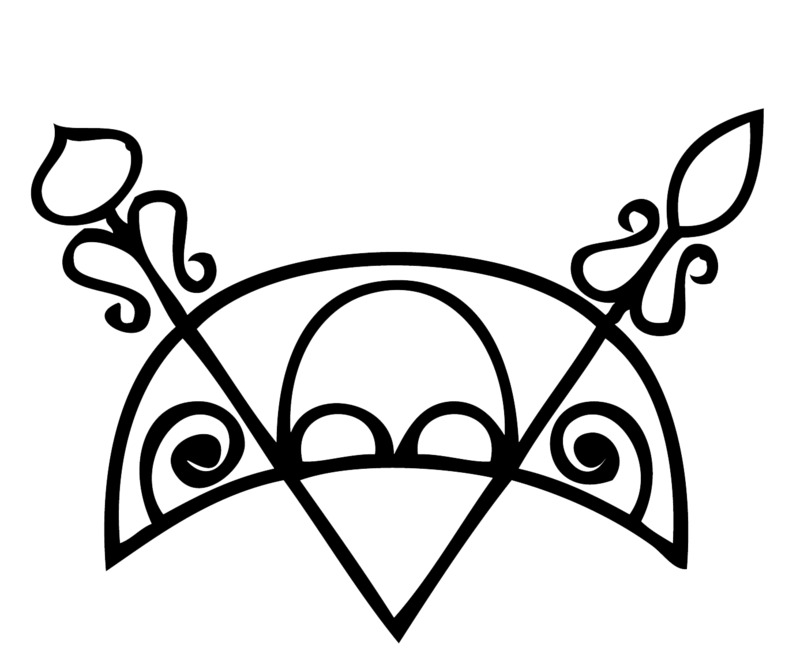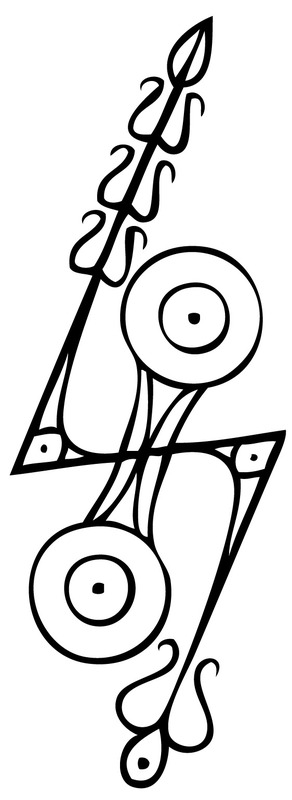Interlace
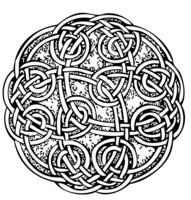 | According to artist George Bain, Religion and Pagan laws had the greatest influence on the art form of Celtic knots, playing an important role in there design. The interlacing of human form and Celtic knots evolved from laws forbidding drawing portraits of human figures as this was tantamount to copying a work of the creator, “God the Almighty,” explains Bain in his book Celtic Art. Similarly, it was forbidden to draw animals or plants. Angels and mythic creatures, on the other hand, were not of the earthly realm. And Saints had departed this realm. Thus, Celtic knot patterns were used to represent most of the human form, while heads, appendages and tails were often depicted using more life-like representations. |
Double Disc Z-Rod
 | The double disc is a Pictish symbol of unknown meaning, that is frequently found on Class I and Class II Pictish stones, as well as on Pictish metalwork. The symbol can be found with and without an overlaid Z-rod (also of unknown meaning), and in combinations of both. |
Human Figures
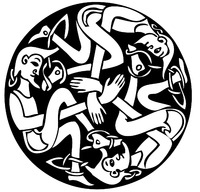 | The representations of human figures by Celtic Artists were influenced by the Pagan Laws that forbade the copying of the works of the Almighty Creator. In Celtic Zoomorphic ornaments the physical appearance of man was not copied. His legs, arms, body, topknot, hair and beard interlaced with each other. Portraiture of a living person, in his created form was a heinous crime. The portrayal of the Saints of the sacred Gospels in the Book of Kells and Lindisfarne was that of a persons who had long departed from earthly habitation and of the angels who were migrants of the Heavenly Host. - George Bain, Celtic Art, The Methods of Construction. |
Crescent V-rod
 | The Crescent and the Crescent with a V-rod through it, appear often on the Pictish Stones. The crescent is thought to symbolise the moon/sun and also thought to symbolise death. The V-rod is thought to be a bent or broken arrow. |
Motif and Z-rod
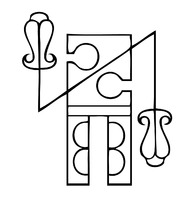 | This symbol is known as the rectangular Motif and Z-Rod, again, this Pictish symbol is of unknown meaning. Also sometimes a square shaped motif with Z-rod symbol is represented. It is thought that the rectangle in the centre of the lower half of these shapes, may represent a doorway. |
Plant Forms
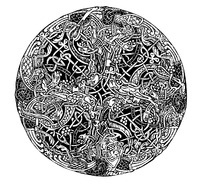 | The reference to the plant forms which rarely occur in the Book of Kells and not at all in the Book of Durrow and Lindisfarne, have been used to prove that the two latter books belong to an earlier period. It is the author’s opinion (George Bain), based upon many evidences, that the Book of Lindisfarne is later than the Book of Kells. Foliated ornaments entered Southern Britain with the Roman invasions, and forms of Gothic foliage came with the invaders after the fall of Rome, but they differ from those of the Pictish Stones of East Scotland and those of the Book of Kells. In the portions of that book that have been available to the author for research, namely the “studio” publication in colours, of some of its most important pages, and “Celtic Illuminative Art” in black and white, by Rev. Stanford F.H. Robinson, M.A., the examples, with one exception, emerge from pots or beakers. The extreme minuteness of these examples make it probable that the pots have not been noticed and no known mention of them has hitherto been made. Without any possible doubt, this is a pagan and, later, a Christian symbol and its use was a religious one and not merely decorative. - George Bain, Celtic Art, the Method of Construction. |
Mirror and Comb
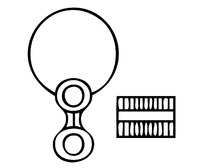 | Another object commonly inscribed on Pictish stones is the mirror, often paired with a comb. The comb and mirror are thought to be symbols of female wealth and prestige, and may denote a woman’s memorial, although they are also heavily associated with mermaids. |
Serpent & Z-rod
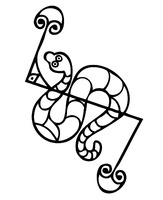 | The serpent or snake, is thought to be a symbol of medicine/healing, although this is unknown. The Z-rod, like the V-rod, may represent a broken arrow or spear, but again this is a Pictish symbol of unknown meaning. |
Spirals
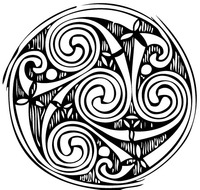 | The noble spirals of Aberlemno, Shandwick, Tarbat, Hilton of Cadboll, Nigg the Tara Brooch, and the Ardagh chalice led the way to the great art of the scribes, who produced the supreme masterpieces of the world’s decoration of books, profusely embellished with spiral art. The few survivors of a great artistic period, the books of Durrow, Kells, Lindisfarne and St. Chad will shed a light for future generations upon the greatness of the art and the other cultures of the Picts and the Briton. - George Bain - Celtic Art, The methods of Construction. |
Zoomorphics
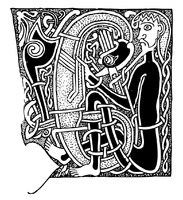 | Zoomorphic ornaments are those based upon the forms of animals, birds and reptiles. Anthropomorphic ornaments are those based upon the forms of the human body. They make an early appearance in the Art of Bronze-age Britain and Ireland, and in the Bronze-age Gaulish, la Tene, and other European forms of Celtic Art. - George Bain - Celtic Art, The Methods of Construction. Zoomorphism is the shaping of something in animal form or terms. Examples include: Art that imagines humans as non-human animals. Art that portrays one species of animal like another species of animal. |
Motif with Triple Disc
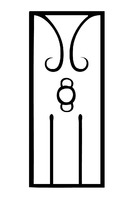 | The triple disc is a Pictish symbol of unknown meaning, that is found on Class I and Class II Pictish stones. The symbol is found in various combinations with other symbols, notably with the crescent and v-rod. The symbol is constructed from a larger central circle flanked with two smaller circles on either side. It is sometimes shown with a "bar" bisecting all three circles. |
Key Pattern
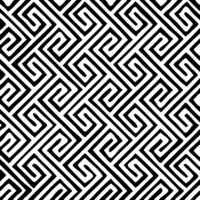 | Key Patterns (repeated vertical and horizontal lines). Know here as the Key Pattern, or a meander or meandros (Greek: Μαίανδρος) it is a decorative border constructed from a continuous line, shaped into a repeated motif. Such a design is also called the Greek fret or Greek key design, although these are modern designations. On the one hand, the name "meander" recalls the twisting and turning path of the Maeander River in Asia Minor, and on the other hand, as Karl Kerenyi pointed out, "the meander is the figure of a labyrinth in linear form". Among some Italians, these patterns are known as Greek Lines. 'J. Romeilly Allen was of the opinion that the essential difference between the classical Key patterns and those used by the Christian Celts of Britain and Ireland, consisted in the introduction of diagonal lines by the latter.' - George Bain, Celtic Art, The Methods of Construction. |
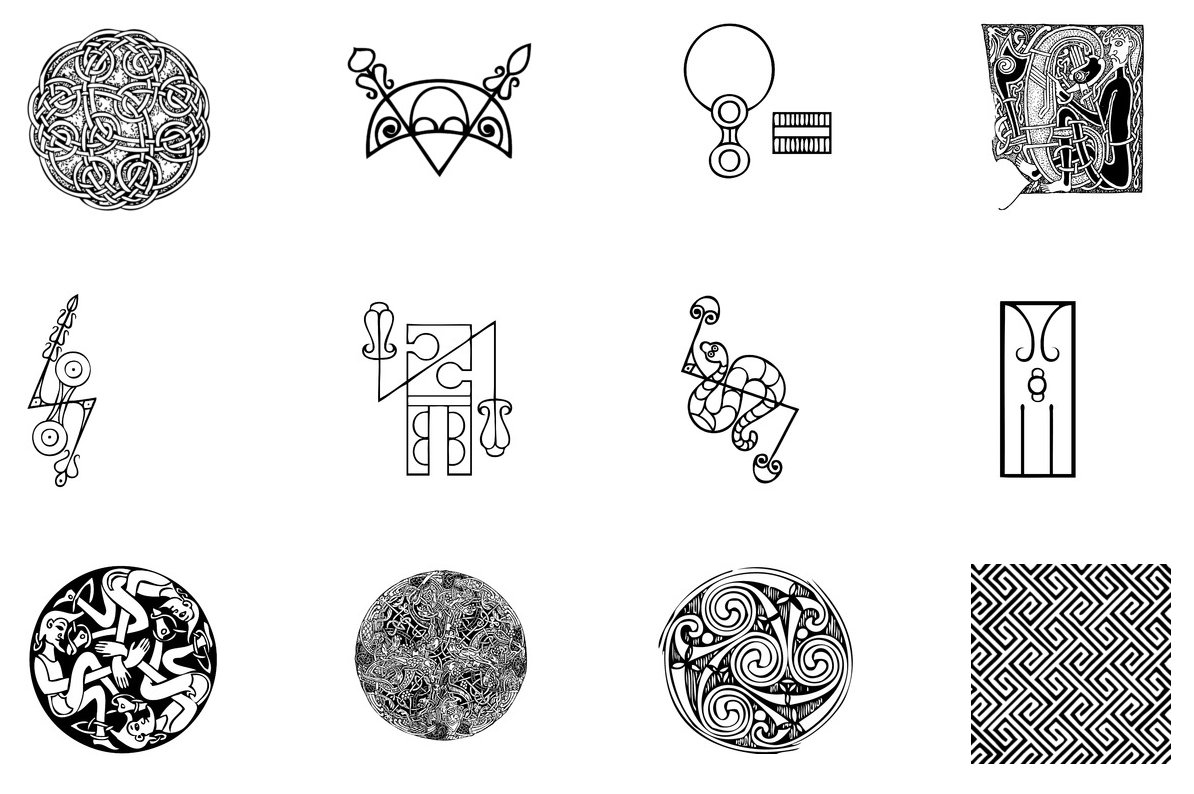
Spirals
A spiral is a curve which emanates from a central point, getting progressively farther away as it revolves around the point.
The noble spirals of Aberlemno, Shadwick, Tarbet, Hilton of Cadboll, Nigg the Tara Brooch, and the Ardagh chalice led the way to the great art of the scribes, who produced the supreme masterpieces of the world’s decoration of books, profusely embellished with spiral art.
The few survivors of a great artistic period, the books of Durrow, Kells, Lindisfarne and St. Chad will shed a light for future generations upon the greatness of the art and the other cultures of the Picts and the Briton. - George Bain - Celtic Art, The methods of Construction.
Knotwork Panels
According to artist George Bain, Religion and Pagan laws had the greatest influence on the art form of Celtic knots, playing an important role in their design.
The interlacing of human form and Celtic knots evolved from laws forbidding drawing portraits of human figures as this was tantamount to copying a work of the creator, “God the Almighty,” explains Bain in his book Celtic Art. Similarly, it was forbidden to draw animals or plants. Angels and mythic creatures, on the other hand, were not of the earthly realm. And Saints had departed this realm. Thus, Celtic knot patterns were used to represent most of the human form, while heads, appendages and tails were often depicted using more life-like representations.
Zoomorphics
Zoomorphism is the shaping of something in animal form or terms. Examples include: art that imagines humans as animals. Art that portrays one species of animal as another.
Zoomorphic ornaments are those based upon the forms of animals, birds and reptiles. Anthropomorphic ornaments are those based upon the forms of the human body. They make an early appearance in the Art of Bronze-age Britain and Ireland, and in the Bronze-age Gaulish, la Tene, and other European forms of Celtic Art. - George Bain - Celtic Art, The Methods of Construction.
Plant Forms
The reference to the plant forms which rarely occur in the Book of Kells and not at all in the Book of Durrow and Lindisfarne, have been used to prove that the two latter books belong to an earlier period. It is the author’s opinion (George Bain), based upon many evidences, that the Book of Lindisfarne is later than the Book of Kells. Foliated ornaments entered Southern Britain with the Roman invasions, and forms of Gothic foliage came with the invaders after the fall of Rome, but they differ from those of the Pictish Stones of East Scotland and those of the Book of Kells. In the portions of that book that have been available to the author for research, namely the “studio” publication in colours, of some of its most important pages, and “Celtic Illuminative Art” in black and white, by Rev. Stanford F.H. Robinson, M.A., the examples, with one exception, emerge from pots or beakers. The extreme minuteness of these examples make it probable that the pots have not been noticed and no known mention of them has hitherto been made. Without any possible doubt, this is a pagan and, later, a Christian symbol and its use was a religious one and not merely decorative.
- George Bain, Celtic Art, the Method of Construction.
Human Figures
The representations of human figures by Celtic Artists were influenced by the Pagan Laws that forbade the copying of the works of the Almighty Creator. In Celtic Zoomorphic ornaments the physical appearance of man was not copied. His legs, arms, body, topknot, hair and beard interlaced with each other. Portraiture of a living person, in his created form was a heinous crime. The portrayal of the Saints of the sacred Gospels in the Book of Kells and Lindisfarne was that of a persons who had long departed from earthly habitation and of the angels who were migrants of the Heavenly Host.
- George Bain, Celtic Art, The Methods of Construction.
Key Patterns
Key Patterns (repeated vertical and horizontal lines).
A Key Pattern, or a meander or meandros (Greek: Μαίανδρος), is a decorative border or area constructed from a continuous line, shaped into a repeated motif.
'J. Romeilly Allen was of the opinion that the essential difference between the classical Key patterns and those used by the Christian Celts of Britain and Ireland, consisted in the introduction of diagonal lines by the latter.' - George Bain, Celtic Art, The Methods of Construction.
Crescent V-rod
The Crescent and the Crescent with a V-rod through it, appear often on the Pictish stones.
The crescent is thought to symbolise the moon/sun or death.
The V-rod is thought to be a bent or broken arrow.
Mirror & Comb
Another object commonly inscribed on Pictish stones is the mirror, often paired with a comb.
The comb and mirror are thought to be symbols of female wealth and prestige, and may denote a woman’s memorial, although they are also heavily associated with mermaids.
Double Disc Z-rod
The double disc is a Pictish symbol of unknown meaning, that is frequently found on Class I and Class II Pictish stones, as well as on Pictish metalwork. The symbol can be found with and without an overlaid Z-rod (also of unknown meaning).
Rectangular Motif and Z-rod
This symbol is known as the rectangular Motif and Z-Rod, again, this Pictish symbol is of unknown meaning.
Also somtimes a square shaped motif with Z-rod symbol is represented.
It is thought that the rectangle in the centre of the lower half of these shapes, may represent a doorway.
Serpent & Z-rod
The serpent or snake, is thought to be a symbol of medicine/healing.
The Z-rod, like the V-rod, may represent a broken arrow or spear, but again this is a Pictish symbol of unknown meaning.
Rectangle with Triple Disc
The triple disc is a Pictish symbol of unknown meaning, that is found on Class I and Class II Pictish stones.
The symbol is found in various combinations with other symbols, notably with the crescent and v-rod. The symbol is constructed from a larger central circle flanked with a smaller circle on either side. It is sometimes shown with a "bar" bisecting all three circles.






